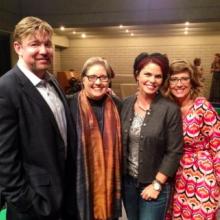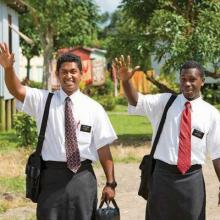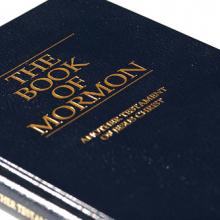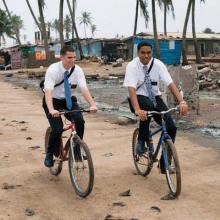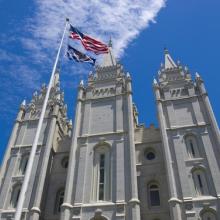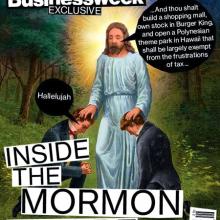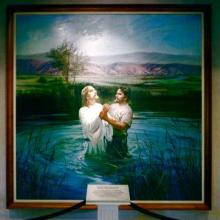Church of Jesus Christ of Latter-day Saitns
It was a gathering that would have been unthinkable just five years ago.
On a cool summer evening, in a borrowed classroom overlooking San Francisco Bay, about 150 men and women gathered to screen a short documentary about a Mormon family whose 13-year-old son came out as gay.
The Montgomerys, who accepted their son and his news, were ostracized by church members, some of whom refused to accept Communion distributed by the young man in church. Like many conservative Christian denominations, the 15 million-member Church of Jesus Christ of Latter-day Saints bans homosexual activity and considers it grounds for exclusion from Mormon rites, rituals and even the afterlife.
SALT LAKE CITY -- Mormon apostle Jeffrey R. Holland predicted that lowering the age limits for young Mormon missionaries would trigger a “dramatic” uptick in their numbers.
Turns out, "dramatic" was an understatement. Try a 471 percent jump in applications — so far.
Just two weeks since Mormon President Thomas S. Monson announced that young men could go on full-time missions for the Church of Jesus Christ of Latter-day Saints at age 18 (down from 19) and young women could go at 19 (down from 21), the Utah-based church has seen applications skyrocket from an average of 700 a week to 4,000 a week.
As an 11-year-old boy, Don Bradley went looking for gold plates.
After all, Mormon founder Joseph Smith said he was directed to a set of such plates, buried in a hill near his house in upstate New York.
On a childhood visit to that hill, Bradley turned over lots of rocks, feeling certain he might find some sacred record overlooked by others.
That quest for Mormon gold became a metaphor for Bradley's lifelong spiritual journey. It led him first to dig into Smith's history to enhance his LDS devotion and then to uncover uncomfortable facts and omissions in the faith's story, which bred disillusionment and distance.
Eventually, Bradley's research helped bring him back to the Mormon fold, this time with a broader view of Smith's spiritual abilities.
"I could describe many of the events of Joseph Smith's life, but I couldn't explain the thing that really mattered: why it all worked," Bradley, now 42, said in a July speech at the annual Sunstone Symposium, a conference in Salt Lake City for Mormon intellectuals. "Joseph Smith wasn't of interest because he'd been a merchant, a mayor, or even a much-married husband, but because he was the founder of a religion. And it was precisely the religious dimension I couldn't account for."
Besides rediscovering Mormonism, Bradley learned how to balance faith and facts, science and spirituality, reason and revelation.
NASHVILLE, Tenn. — Jake Pulsipher's first day as a working missionary for the Southern Baptist Convention's North American Mission Board began at 6:30 a.m. with prayer and exercise, followed by breakfast and study.
Then he put on a black suit, white shirt, and red tie, along with his official name tag, and headed out to knock on doors and tell people about Jesus. In doing so, he became the latest of 20,000 Mormon missionaries in the United States.
Every year, the Southern Baptist Convention and the Church of Jesus Christ of Latter-day Saints spend tens of millions of dollars to spread their takes on Christianity. They rely heavily on thousands of faithful volunteers willing to spread out across the country to share their faith.
The two groups are among the four largest denominations in the United States -- Southern Baptists are second and Church of Jesus Christ of Latter-day Saints fourth, according to the Yearbook of American and Canadian Churches from the National Council of Churches. The Catholic Church is No. 1 and the United Methodist Church is No. 3.
They are also competitors for converts, says Richard Land, president of the Southern Baptist Convention's Ethics and Religious Liberty Commission.
''Methodists are not out knocking on doors. Mormons are,'' he said.
Stephen Mansfield, an evangelical author who has written widely about the faith of politicians, turns his attention to Mormons in his latest book, The Mormonizing of America.
He talked with Religion News Service about how the Church of Jesus Christ of Latter-day Saints — including GOP presidential candidate Mitt Romney — has progressed from persecution to prominence.
The interview has been edited for length and clarity.
Q: You’ve written “The Faith of George W. Bush” and The Faith of Barack Obama. Why did you write “The Mormonizing of America” instead of “The Faith of Mitt Romney”?
A: I thought that the story of Bush at the time was bigger than the story of evangelicals and the religious right at that time. I thought the story of Obama personally was bigger then the story of the religious left that he was sort of the champion of. But in this case I think that the story of the Mormon moment or this Mormon ascent is a bigger story than Mitt Romney. There’s something broader going on and he’s not so much the champion of the movement, maybe just at the vanguard of it....
The Mormon church is lashing back at a business magazine that parodied their prophet’s mission and portrayed the church as lucratively rich but miserly with charitable donations.
A lengthy story in Bloomberg Businessweek that hits newsstands on Friday details The Church of Jesus Christ of Latter-day Saints’ vast financial holdings, from a $2 billion mall in Salt Lake City to a $1 billion ranch in Florida.
Reaction to the magazine’s cover has overshadowed the article, however. The illustration satirizes the moment when Mormons believe John the Baptist bestowed the priesthood on Joseph Smith, the faith's founding prophet.
In the parody, John the Baptist tells Smith, “and thou shalt build a shopping mall, own stock in Burger King, and open a Polynesian theme park in Hawaii that shall be largely exempt from the frustrations of tax ...” Smith answers, “Hallelujah.”
LDS church spokesman Michael Purdy said the magazine cover is “in such poor taste it is difficult to even find the words to comment on it.”
The Church of Jesus Christ of Latter-day Saints has apologized for a Mormon who baptized the late parents of famed Nazi-hunter Simon Wiesenthal. But despite calls this week from Holocaust survivor and Nobel laureate Elie Wiesel (and others) to rethink the controversial rite, the church is unlikely to drop it entirely.
Latter-day Saints trace posthumous baptism to the Apostle Paul, who wrote in 1 Corinthians 15:29, "Else what shall they do which are baptized for the dead, if the dead rise not at all? Why are they then baptized for the dead?" Mormons believe that Joseph Smith, their faith's founding prophet, restored the apostolic practice after centuries of neglect by mainstream Christians.
Proxy baptism was also Smith's answer to a classic Christian conundrum: What happens to people who, through no fault of their own, did not join the church during their earthly lifetime? Should they be barred from heaven?
Mormons believe that vicarious baptisms give the deceased, who exist in the afterlife as conscious spirits, a final chance to join the Mormon fold, and thus gain access to the Celestial Kingdom. To Mormons, only members of the LDS priesthood possess the power to baptize.
I spent the weekend in New York at a conference I co-organized on Mormonism and American politics. We had two days of stimulating papers and presentations, an overview of which you can read here. One of my favorite talks was by veteran religion reporter Peggy Fletcher Stack, who has been covering Mormonism (and every other faith) for years for the Salt Lake Tribune and had some advice for journalists who suddenly find themselves trying to understand Mormonism this year during the Romney campaign.
Peggy’s basic thesis was that many reporters cover Mormonism using a basic paradigm taken from covering Protestantism, and fail to appreciate important differences. Find out what Peggy's the top six mistakes journalists make are inside the blog...
